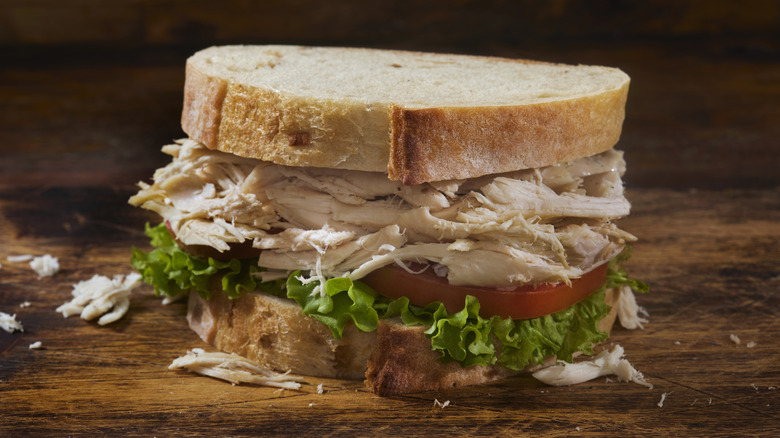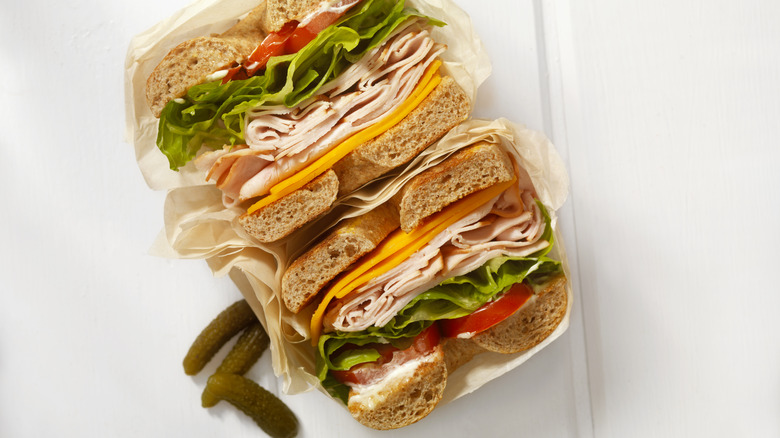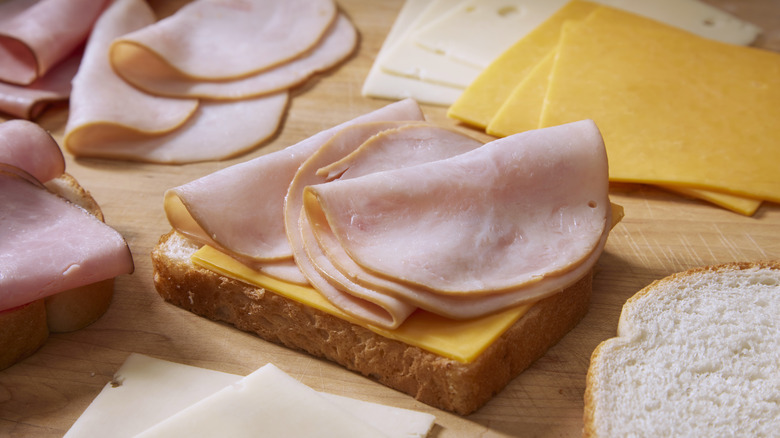The Best Way To Wrap A Sandwich So It Doesn't Get Soggy
From a hearty stack of pancakes drenched in velvety maple syrup and decadent slices of tres leches cake to a milky bowl of your favorite cereal, some foods taste better when they're moistened to a goopy perfection. Put simply: The mushier the mouthfeel, the better the taste. However, the same can certainly not be said for sandwiches. After all, nothing spells hangry disappointment quite like diving into your packed lunch only to find your bread has gone soggy thanks to its layers upon layers of tasty fillings and condiments.
Of course, the best way to prevent a quaggy sandwich is to savor it right after you make it. However, that's not always possible — especially if you're packing it to enjoy at a later time. Fortunately, there's another option to help you easily avoid soggy picnic sandwiches and similar lunchtime woes, and it involves a simple storage tip: wrapping your sandwich in parchment paper to help keep excess moisture at bay.
Wrap your sandwich in parchment paper
Using quality ingredients and only the freshest of bread tops the list of the dos and don'ts of making a sandwich. But the way you wrap it is equally important, too — at least if you're keen on biting into a sandwich that's mush-free. Wrapping your sandwich in parchment paper is a good option because the material is porous, allowing your bread to breathe while still keeping excess moisture away. Just be sure to double-wrap your sandwich — wrapping it once, cutting it in half, and wrapping it again — for added protection.
And, if you have the time, wrapping all of your moist ingredients separately and then assembling them when you're ready to eat is an even better way of ensuring your bread doesn't turn to mush. Because all of the moisture from condiments like mustard and other wet ingredients like pickles, sauerkraut, cucumbers, and tomatoes can seep into your bread and cause it to go soggy, packing them in separate storage containers can make all the difference. This is especially true if you're tucking into the likes of an egg, chicken, or tuna sandwich or warmer fillings like grilled chicken, which can produce condensation and also make for even soggier bread.
Other ways to prevent a soggy sandwich
If you don't have any parchment paper on hand, or you're short on time and are unable to pack your sandwich fillings separately, there are other ways you can ensure your bread remains in its preferred fluffy and moist-free form. For more sandwich "dos," at least when it comes to preventing unwanted gooey bread, be sure to stack your sandwich ingredients in a way that keeps the wettest fillings from touching the roll, bun, or baguette. For example, you can place your lettuce, spinach, or other leafy greens between the bread and your other fruit and veggies to prevent their moisture from soaking your bread.
And, for the best-tasting — and slop-free — sandwich, consider giving your bread a little crunch by toasting one side. But, instead of assembling your sandwich with the toasted side facing outward, layer all of your wet ingredients on the toasted side instead. This will help prevent your bread from going soggy because the crispy, browned layer will actually act as a barrier against all of the added moisture, too.



